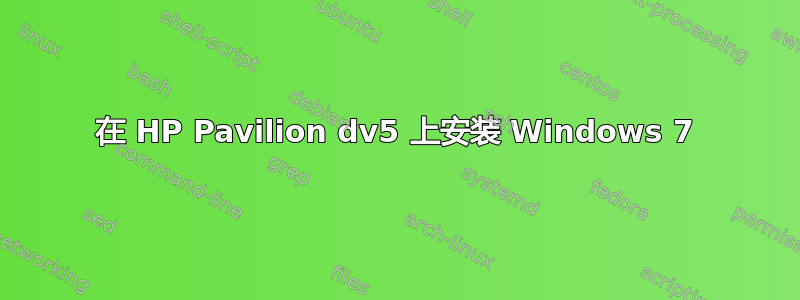
我正在尝试在我的 HP Pavilion dv5 笔记本电脑上安装 Windows 7,但没有成功。
我遵循的程序如下:
- 将 Windows 7 DVD 插入我的 CD/DVD ROM。
- 按下F9即可执行可启动菜单。
- 选择内部 CD/DVD 可启动。
- 按 Enter 键从 CD/DVD 启动。
然后出现一个黑屏,其中有一个灰色条正在加载设置,加载过程结束后立即显示 Windows 7 徽标(正在启动 Windows 7)。
在此阶段之后,我得到一个黑屏,而我所能看到的只是屏幕上的鼠标。
我将同一张 CD/DVD 放到我的台式电脑上,在最后一个阶段(启动 Windows 7)之后,安装的蓝屏就出现了,也就是说,该问题与 CD/DVD 本身无关。
你能帮我理解我做错了什么吗?我买的笔记本电脑附带 Vista,所以无法安装 Windows 7 吗?BIOS 菜单中有一个字段显示我的出厂操作系统为 Vista。
答案1
有时屏幕需要很长时间才能加载(当我格式化我的电脑时也需要很长时间才能加载)我建议您保持耐心并等待它加载。
预装 Vista 对能否安装 Windows 7(或任何其他操作系统,如 Ubuntu)没有任何影响
此外,您还可以尝试从 USB 驱动器安装 Windows 7。请查看这
就是这样:
Create an ISO file from the Windows 7 DVD. If you already know how to create ISO images, fantastic: do it, and then come back here for further instructions on what to do with it.
If you've never created an ISO file from a disc before, check out the tutorial linked above. It'll walk you through installing some free software and then using it to create the ISO. An ISO image is a single file that perfectly represents a disc... in this case, your Windows 7 installation DVD.
Next we're going to work on properly getting that Windows 7 ISO image you just created onto the flash drive.
Download the Windows 7 USB/DVD Download Tool from Microsoft. Once downloaded, execute the file and follow the installation wizard.
This free program from Microsoft, which works in Windows 8, Windows 7, Windows Vista, or Windows XP, will correctly format the USB drive and then copy the contents of your Windows 7 ISO file to the drive.
Start the Windows 7 USB DVD Download Tool program, which is probably located in your Start menu or on your Start screen, as well as on your Desktop.
On the Step 1 of 4: Choose ISO file screen, click Browse.
Locate, and then select, your Windows 7 ISO file. Then click Open.
Note: If you downloaded Windows 7 directly from Microsoft, check for the ISO image wherever you tend to store downloaded files. If you manually created an ISO file from your Windows 7 DVD in Step 1 above then it will be wherever you created it to.
Click Open.
Click Next once you're back on the Step 1 of 4 screen.
Click USB device on the Step 2 of 4: Choose media type screen.
On the Step 3 of 4: Insert USB device screen, choose the flash drive or external hard drive you want to put the Windows 7 installation files on.
Tip: If you haven't yet plugged in the flash drive or other device you're using then you can do that now. Just click the blue refresh button to make it show up in the list.
Click the Begin copying button.
Click Erase USB Device if you're prompted to do so on a Not Enough Free Space window. Then click Yes to the confirmation in the next window.
Note: If you don't see this it just means that the flash drive or external hard disk you've selected is already empty.
Important: Any data you have on this USB drive will be erased as part of this process.
On Step 4 of 4: Creating bootable USB device, wait for the Windows 7 USB DVD Download Tool to format the USB drive and then copy the Windows 7 installation files to it from the ISO image you provided.
You'll see a Status of Formatting for several seconds, followed by Copying files. This part might take as long as 30 minutes, maybe even longer, depending on which edition of Windows 7 the ISO file you have is from, as well as on how fast your computer, USB drive, and USB connection is.
Tip: The percentage complete indicator may sit on one or more percentages for a long time. This does not mean anything is wrong.
The next screen you see should say Bootable USB device created successfully.
You can now close the Windows 7 USB DVD Download Tool program. The USB drive can now be used to install Windows 7.
Boot from the USB device to start the Windows 7 setup process.
Tip: You may need to make changes to the boot order in BIOS if the Windows 7 setup process doesn't start when you try to boot from the USB drive. See How To Change the Boot Order in BIOS if you've never done that.
Tip: If you still can't get the flash drive to boot, and you also have a UEFI based computer, see Tip #1 below for help.
Note: If you arrived here from How To Clean Install Windows 7, you can now return to that tutorial and continue installing Windows 7. See How To Install Windows 7 if you weren't doing a clean install or you're not sure what kind of installation to do.


